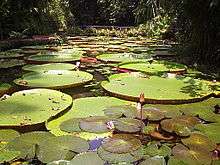Museu Paraense Emílio Goeldi
 Vitória Régia, in Paraense Emílio Goeldi Museum | |
 Location within Brazil | |
| Established | 1866 |
|---|---|
| Location | Belém, Pará, Brazil |
| Coordinates | 1°27′09″S 48°28′35″W / 1.4525°S 48.4764°WCoordinates: 1°27′09″S 48°28′35″W / 1.4525°S 48.4764°W |
| Type |
Natural history museum, arboretum zoological garden |
| Director | Nilson Gabas Jr. |
| Website | www.museu-goeldi.br |
The Museu Paraense Emílio Goeldi is a Brazilian research institution and museum located in the city of Belém, state of Pará. It was founded in 1866 by Domingos Soares Ferreira Penna as the Pará Museum of Natural History and Ethnography, and was later named in honor of Swiss naturalist Émil August Goeldi, who reorganized the institution and was its director from 1894 to 1905. It is open to the public from 9:00 to 17:00 h, daily except Mondays.
Activities
The institution has the mission of researching, cataloging and analyzing the biological and sociocultural diversity of the Amazon Basin, contributing to its cultural memory and its regional development. It has also the aim of increasing public awareness of science in the Amazon by means of its museums, botanical garden, zoological park, etc.
The Museum maintains a scientific research station in the high Amazon forest (Estação Científica Ferreira Penna), which was inaugurated in 1993, with 330 square kilometres (130 sq mi) in the Caxiuanã National Forest, municipality of Melgaço, Pará.
The museum provided assistance in preparing the management plan for the Grão-Pará Ecological Station between 2007 and 2011. This is a strictly protected environmental unit covering 4,245,819 hectares (10,491,650 acres) of Amazon forest created in 2006, the largest such reserve in the world.[1]
Botany
The Museum staff in botany works in taxonomy and systematics of the Amazon flora, ethnobotany and economic botany, plant biodiversity, structure and dynamics of rain forests. A botanical garden and several botanical collections are maintained, since the first one, established in 1895 by Jacques Huber, and it has more than 150,000 specimens of seeds, fruits, woods, pollen, histological sections and exsicata (dried and pressed specimens).
Zoology
In zoology, the Museum does research on the Amazon fauna, its geographical distribution, behavior, ecology, taxonomy and systematics in mammalogy, ornithology, herpetology, ichthyology and entomology. The zoological collections include around 150,000 specimens of vertebrate whole bodies preserved in alcohol and taxidermy, skeletons, skins, eggs, anatomical parts, etc.; as well as more than 1 million specimens of invertebrates, including Arthropoda, Insecta and Mollusca.
Earth sciences
In this area, there are research groups on the evolution of Amazon ecosystems, paleontology and paleoecology of tropical regions, sedimentology, mineralogy and stratigraphy, geology, geochemistry, paleogeology and pedology (the study of soils). The paleontological collections harbored by the Museum have more than 6,000 species, and the mineralogical collections more than 1,000 samples.
Human sciences
The existence of a rich pre-history and contemporaneous history of human populations in the Amazon have motivated, since the beginning of the Museum, a host of studies in archeology, anthropology, linguistics and ethnography. The institution is probably the largest repository of such Amazonic collections in the world, with more than 81,000 pieces in the archeological collection, including lithic and ceramic artifacts, and more than 14,000 pieces in the ethnographic collection, including indigenous cultures from Brazil, Africa, Peru and Suriname. The linguistics sector studies many aboriginal languages.
Past directors
João Baptista Gonçalves da Rocha (1872–1873); Joaquim Pedro Corrêa de Freitas, Diretor de Instrução Pública (1873–1881); José Coelho da Gama e Abreu, Barão de Marajó (1881–1882); Antonio Manuel Gonçalves Tocantins (1882); Domingos Soares Ferreira Penna (1882–1884); Joaquim Pedro Corrêa de Freitas (1883–1884); Hildebrando Barjona de Miranda; Abel Augusto César de Araújo (1885); Álvaro Pinto de Pontes e Souza (1886–1888); Emílio Augusto Goeldi (1894–1907); Jacques Hüber (1907–1914); Marie Emilie Snethlage (1914–1921); Rodolfo Siqueira Rodrigues (substitute); Carlos Estevão de Oliveira (1930–1936); José Cândido de Melo Carvalho (1955–1960). José Seixas Lourenço(); Guilherme Mauricio Souza Marcos de La Penha(1985–1991).
References
- ↑ José Alberto da Silva Colares (July 2011), Plano de Manejo da Estação Ecológica do Grão-Pará: Resumo Executivo (PDF) (in Portuguese), Belém: Secretaria de Estado de Meio Ambiente (SEMA), pp. 7ff, retrieved 2016-05-12
| Wikimedia Commons has media related to Museu Paraense Emílio Goeldi. |
External links
- Museu Paraense Emilio Goeldi.
- "Museu Paraense de História Natural e Etnografia" page at Dicionário Histórico-Biográfico das Ciências da Saúde no Brasil (1832-1930)